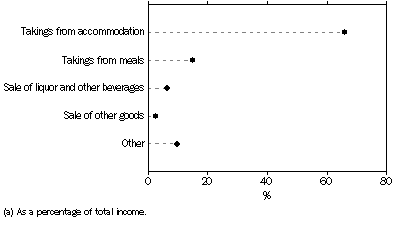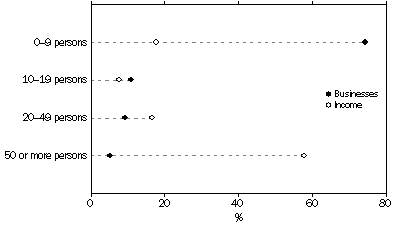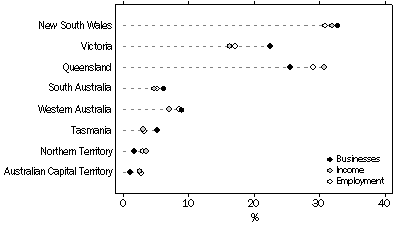INTRODUCTION
This publication presents results from an Australian Bureau of Statistics (ABS) survey of accommodation businesses. The survey was conducted in respect of the 2003-04 financial year.
The 2003-04 Accommodation Survey is the seventh ABS survey of accommodation businesses. Previous collections were conducted in respect of the 2000-01, 1997-98, 1995-96, 1991-92, 1986-87 and 1979-80 financial years.
MORE INFORMATION ON ABS SERVICE INDUSTRIES STATISTICS
Information about ABS activities in the field of service industries statistics is available from the Service Industries Statistics theme page on the ABS web site <https://www.abs.gov.au>. To access the theme page, select 'Themes' from the menu on the home page.
COMMENTS
The ABS welcomes comments and suggestions from users regarding future surveys of Service Industries. These comments should be addressed to the Director, Service Industries Business Statistics Centre, Australian Bureau of Statistics, GPO Box 2796Y, Melbourne, Vic. 3001.
ROUNDING
Where figures have been rounded, discrepancies may occur between the sum of component items and the total.
INQUIRIES
For further information about these and related statistics, contact the National Information and Referral Service on 1300 135 070 or William Milne on Melbourne (03) 9615 7862.
MAIN FEATURES
INTRODUCTION
This publication presents results of the 2003-04 Accommodation Survey. This survey is conducted periodically by the ABS to provide detailed measures of the performance, structure and activity of accommodation businesses operating in Australia. It includes aspects such as: the composition of income earned, details of expenses incurred and the characteristics of the workforce. A state dimension is also presented.
The survey scope included employing and significant non-employing businesses in Australia that generated income predominantly from the provision of accommodation services. This included businesses providing short-term accommodation services such as licensed hotels, motels, serviced apartments, visitor hostels, bed and breakfast locations, guest houses and holiday homes/flats. The scope also included businesses providing both short-term and long-term accommodation in privately operated holiday parks/caravan parks/camping grounds and student residences (excluding boarding schools).
For ease of reading, references to holiday parks/caravan parks/camping grounds are referred to collectively as caravan parks.
SUMMARY OF FINDINGS
At the end of June 2004 there were 5,682 accommodation businesses operating in Australia. These businesses had employment of 91,399 persons.
In 2003-04, income generated by accommodation businesses was $8,095.9m, which represented an average of $1,424,800 per business. Total expenses incurred for this same period were $7,322.3m.
The total industry value added of these businesses was $4,165.9m, which equates to 0.5% of Australia's gross domestic product (GDP) for 2003-04.
In 2003-04, the operating profit before tax for these businesses was $776.7m, resulting in an operating profit margin of 9.7%.
During 2003-04 accommodation businesses incurred $1,120.6m in capital expenditure, with renovations and refurbishments accounting for 16.1% ($180m).
BUSINESS CHARACTERISTICS
The 5,682 accommodation businesses at the end of June 2004 operated 6,372 accommodation locations around Australia.
The largest contributor to accommodation types was motels with 2,396 locations which represented 37.6% of all locations. The second largest contributor was caravan parks with 19.7% (1,253 locations) of all locations. Serviced apartments and licensed hotels accounted for 9.1% (578 locations) and 8.4% (535 locations) of all locations respectively.
SOURCES OF INCOME
During 2003-04 accommodation businesses generated a total of $8,095.9m in income.
The following graph shows that the main source of income was takings from accommodation, comprising just under two thirds (66% or $5,346.4m) of total income. Other major income items were takings from meals which accounted for 15.1% ($1,223.8m) of all income, and sale of liquor and other beverages which accounted for 6.5% ($524m).
SELECTED SOURCES OF INCOME(a)

EXPENDITURE
Accommodation businesses incurred $7,322.3m in expenses during 2003-04. Labour costs were the highest single expense item accounting for 35% ($2,565.9m) of the total, followed by purchases (12.8% or $934m) and rent, leasing and hiring (9.5% or $697.2m).
The average labour costs per employee were $28,800.
EMPLOYMENT
At the end of June 2004, accommodation businesses had employment of 91,399 persons.
Persons employed on a casual (or temporary) basis represented 45.3% (41,433 persons) of total employment. Permanent full-time employees accounted for 41% (37,439 persons) while permanent part-time employees accounted for 11.2% (10,239 persons) of total employment.
Females dominated the work force accounting for 60.7% (55,441 persons) of all employment. Females were more likely to be employed in casual positions, accounting for 53% (29,405 persons) of all female employment.
There were 2,289 (2.5%) working proprietors and partners of unincorporated businesses at the end of June 2004.
SIZE OF BUSINESSES
The following graph shows that the majority (74.3% or 4,219) of accommodation businesses employed fewer than 10 persons. These businesses accounted for 17.8% ($1,438.4m) of total income which represented $340,900 per business. The total operating profit before tax of these businesses was $228.7m (or $54,200 per business).
Large businesses (those employing 50 persons or more), on the other hand, accounted for only 5.4% (304) of all businesses, but generated over half of all income (57.9% or $4,685.6m). This represented $15.4m per business. The total operating profit before tax of these businesses was $314.5m (or $1,034,500 per business).
KEY CHARACTERISTICS BY BUSINESS SIZE

STATES AND TERRITORIES
The following graph shows that New South Wales accounted for the highest share of business counts, income and employment, followed by Queensland and Victoria.
New South Wales accounted for 32.8% (1,861) of all accommodation businesses, followed by Queensland (25.5% or 1,450) and Victoria (22.5% or 1,279).
New South Wales and Queensland accounted for 32% ($2,588.5m) and 30.7% ($2,488.3m) of all income, with Victoria contributing 16.3% ($1,323.4m) to total income.
Employment in New South Wales comprised just under a third of all employment (30.9% or 28,234 persons), Queensland had 29.1% (26,553 persons) while Victoria contributed 17.1% (15,654 persons).
KEY CHARACTERISTICS BY STATE AND TERRITORY

HISTORICAL COMPARISONS
Comparisons with results from earlier surveys are useful as an indication of the extent of change over time. However, the survey was not designed to provide highly accurate estimates of change, so any comparisons with results from previous surveys should be made with caution. Estimates of change can be subject to changes in scope and coverage or question wording, or high levels of sampling error. Further information can be found in paragraphs 21-29 of the Explanatory Notes.
Taking into consideration these limitations, the 2003-04 survey results indicate that accommodation services experienced little or no growth between the two reference periods 2000-01 and 2003-04.
There are a number of external factors, in particular the 2000 Sydney Olympic Games, which need to be considered when comparing the two reference periods.
While total income for accommodation businesses increased by an average 0.7% per annum since 2000-01 (from $7,934.8m to $8,095.9m), takings from accommodation increased by 3.7% per annum (from $4,791.6m to $5,346.4m). However takings from meals, and sales of liquor and other beverages, decreased for the period by 2.1% and 3.9% per annum respectively. Other income also decreased by 7% per annum.
Over the period expenditure increased by 0.3% per annum (from $7,258.1m to $7,322.3m).
Employment also decreased from 100,401 persons at the end of June 2001 to 91,399 persons at the end of June 2004. This represents an average decline of 3.1% per annum.
Between 2000-01 and 2003-04, labour costs decreased by 0.2% per annum (from $2,580.1m to $2,565.9m).
Operating profit before tax grew at an average annual rate of 4.1% (from $688.2m in 2000-01 to $776.7m in 2003-04), and the operating profit margin increased from 8.3% to 9.7%.
CARAVAN PARKS
Data are also presented for privately owned caravan park businesses operating in Australia. The scope included employing and significant non-employing businesses that generated income predominantly from the provision of caravan park accommodation services. Caravan park businesses included holiday parks, caravan parks and camping grounds.
At the end of June 2004, there were 1,253 caravan park locations operating around Australia. These locations generated income of $844.4m in 2003-04. The majority (89.9% or $759.3m) of the income was received from takings from accommodation. Sales of other goods accounted for 4.4% ($36.8m) of total caravan park income.
During 2003-04, caravan parks incurred expenses of $681m. The single largest expense item was labour costs accounting for just under a third of all expenses (31.5% or $214.8m). Depreciation and amortisation accounted for 9.8% ($66.8m) of total expenses, repair and maintenance costs accounted for 8.3% ($56.2m), and purchases 7.9% ($53.5m).
At the end of June 2004, privately operated caravan parks had employment of 9,330 persons. Casual employment accounted for just under half of all employment (49.9% or 4,651 persons). Permanent full-time employees accounted for 40.9% (3,817 persons) of total employment.
Females comprised the majority (62.8% or 5,858 persons) of all employment and were more likely to be employed on a casual basis (3,551 persons).
There were 290 (3.1%) working proprietors and partners of unincorporated businesses working in caravan parks at the end of June 2004.
SUMMARY OF OPERATIONS |
|  |
 |  |  | r2000-01(a) | 2003-04 | Average annual percentage change 2000-01 to 2003-04 |  |
|  |
| Businesses at end June | no. | 5,870 | 5,682 | -1.1 |  |
| Employment at end June | no. | 100,401 | 91,399 | -3.1 |  |
| Income |  |  |  |  |  |
 | Takings from accommodation | $m | 4,791.6 | 5,346.4 | 3.7 |  |
 | Takings from meals | $m | 1,305.1 | 1,223.8 | -2.1 |  |
 | Sale of liquor and other beverages | $m | 591.1 | 524.0 | -3.9 |  |
 | Other | $m | 1,247.0 | 1,001.7 | -7.0 |  |
 | Total | $m | 7,934.8 | 8,095.9 | 0.7 |  |
| Expenses |  |  |  |  |  |
 | Labour costs | $m | 2,580.1 | 2,565.9 | -0.2 |  |
 | Purchases of foodstuffs for use in preparing meals | $m | 459.8 | 423.8 | -2.7 |  |
 | Purchases of liquor and other beverages | $m | 234.5 | 195.9 | -5.8 |  |
 | Other | $m | 3,983.8 | 4,136.8 | 1.3 |  |
 | Total | $m | 7,258.1 | 7,322.3 | 0.3 |  |
| Operating profit before tax | $m | 688.2 | 776.7 | 4.1 |  |
| Operating profit margin | % | 8.3 | 9.7 | . . |  |
| Industry value added | $m | 3,616.2 | 4,165.9 | 4.8 |  |
| Capital expenditure |  |  |  |  |  |
 | Renovations and refurbishments | $m | na | ^180.0 | . . |  |
 | Other | $m | na | 940.5 | . . |  |
 | Total | $m | na | 1,120.6 | . . |  |
|  |
| ^ estimate has a relative standard error of 10% to less than 25% and should be used with caution |
| . . not applicable |
| na not available |
| (a) r revised. Excluded non-employing businesses. For further information, refer to Explanatory Notes paragraph 21. |
 Print Page
Print Page
 Print All
Print All